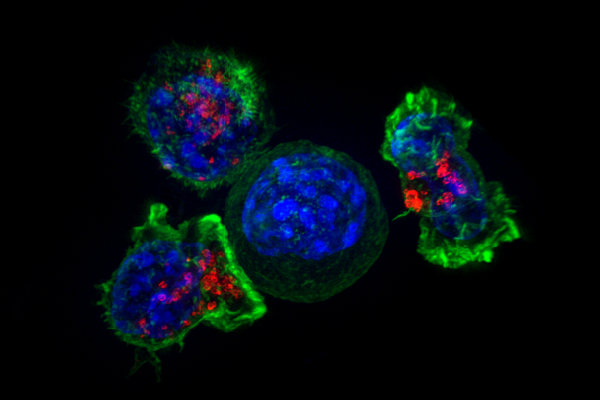Researchers identify enzyme link between excessive heart muscle growth, cancer growth

UT Southwestern Medical Center cardiology researchers have identified molecular ties between the growth of cancer cells and heart cells that suggest existing cancer drugs may be able to help those with enlarged heart cells—a condition that can lead to heart attacks and stroke.
Researchers with UT Southwestern's Harry S. Moss Heart Center were able to unravel the molecular workings behind enzymes called HDACs that are known to spur the spread of cancer. Inhibiting them can also blunt excess enlargement of heart muscle cells, a condition known as cardiac hypertrophy. The findings suggest that drugs currently used to inhibit these enzymes in cancer may also be effective in treating enlargement of the heart muscle, the researchers reported.
"This work opens the possibility of repurposing a drug that has been in use in cancer treatment for over a decade to target hypertrophic heart disease, a form of heart disease for which we have no effective therapy," said senior author Dr. Joseph Hill, Chief of Cardiology and Director of the Harry S. Moss Heart Center at UT Southwestern. "We hope eventually to test this idea in clinical trials. Doing so is the Holy Grail for a physician-scientist - to translate fundamental molecular discoveries made in preclinical studies to humans."
High blood pressure, also known as hypertension, can cause the heart muscle to work harder, resulting in the expansion of heart cells, which causes the walls of the heart to thicken. The condition, known as cardiac hypertrophy, can lead to heart failure if not stopped. Symptoms of cardiac hypertrophy can include shortness of breath, fatigue, fainting, and chest pain.
"This work strengthens our emerging understanding of commonalities between cancer and heart disease," said Dr. Hill, who holds the James T. Willerson, M.D. Distinguished Chair in Cardiovascular Diseases and the Frank M. Ryburn, Jr. Chair in Heart Research. "In some cells, disruption of a molecular pathway can lead to cancer, whereas perturbations of that same pathway in heart cells can lead to heart failure. Thus, there are interesting and sometimes surprising commonalities across the biologies of cancer and heart disease."
Dr. Hill's lab, which studies cardiac hypertrophy, has focused on alterations in the processing of DNA, the blueprint of all cells, in heart disease. Recently, his group has found that targeting processes known to be disrupted in cancer can confer benefit in heart disease.
The group of enzymes targeted in this study are known as class 1 histone deacetylases (HDACs), which help regulate the replication and repair of DNA. HDACs can spur the growth of cancer cells. Drugs that inhibit this ability halt or slow the spread of cancer cells.
In this study, researchers unraveled the molecular processes at work behind the scenes of those processes, and found that suppressing HDACs also suppressed the activity of a critical molecule called mTOR (mechanistic target of rapamycin), which regulates the growth of cells. Mice that had been genetically altered to shut off HDAC activity reduced mTOR activity and slowed the enlargement of cardiac muscle cells. The work went on to decipher the molecular circuitry linking HDAC activity and mTOR.
"HDAC inhibitors are approved to treat various cancers, and our results suggest how these drugs might work when repurposed to prevent heart failure," said lead author Dr. Cyndi Morales, a postdoctoral researcher with the Harry S. Moss Heart Center.
The work also adds to a growing understanding that epigenetic mechanisms, which are external factors that govern DNA expression, are a fruitful area of research for heart disease, said Dr. Hill, Professor of Internal Medicine and Molecular Biology.
Heart disease is the leading cause of death in the U.S. in both men and women, with more than 600,000 Americans dying of heart disease annually, or one in four deaths each year, according to the Centers for Disease Control and Prevention.
The study, which appears in the journal Science Signaling, was supported by grants from the National Institutes of Health, the American Heart Association, the Cancer Prevention and Research Institute of Texas, and the Comisión Nacional de Investigación Cientiffica y Tecnológica.
More information: C. R. Morales et al. Inhibition of class I histone deacetylases blunts cardiac hypertrophy through TSC2-dependent mTOR repression, Science Signaling (2016). DOI: 10.1126/scisignal.aad5736



















